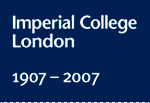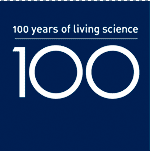Virgil Scott
(Mechanical Engineering, 2004-present)
shares his breath taking adventures of sheer drops, and steep mountain climbs
In the summer of 2007 four other Imperial College students and I went to the Quimsa Cruz mountain range in Bolivia to climb new routes and explore the area for rock climbing potential. We climbed eleven mountain routes, ten of which we believe had never been climbed before. It was an unforgettable experience, we all enjoyed ourselves tremendously, and we are already planning another expedition for September 2008.
We met on the 24 June in the Imperial College Mountaineering Club equipment stores to distribute our gear and pack our rucksacks. We had a flight from Gatwick to Madrid in the afternoon. From Madrid we flew to Santa Cruz, via a pit stop in Brazil. In Santa Cruz airport we spent the night on comfy benches near televisions that wouldn’t stop playing Bolivian Panpipe music all night long.
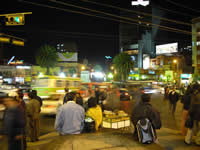 The air was noticeably thinner as we stepped out of the plane at La Paz. We drove to our hotel and spent the afternoon finding our way around the markets and shops. We aimed to spend the next few days relaxing and acclimatising. Photo left: La Paz at night.
The air was noticeably thinner as we stepped out of the plane at La Paz. We drove to our hotel and spent the afternoon finding our way around the markets and shops. We aimed to spend the next few days relaxing and acclimatising. Photo left: La Paz at night.
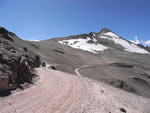 A seven hour trip in a couple of 4x4s brought us to our base camp in the mountains. After two hours on paved asphalt the road turned into a rough dirt track. It was narrow and appeared to have almost no passing points. Occasionally our driver had to slow to a halt and engage the differential lock to get over the rough sections. We swept around tight hairpins, disturbingly close to sheer drops. We traversed several turquoise lakes and passed through a number of small farming and mining settlements, some of them abandoned and decaying.
A seven hour trip in a couple of 4x4s brought us to our base camp in the mountains. After two hours on paved asphalt the road turned into a rough dirt track. It was narrow and appeared to have almost no passing points. Occasionally our driver had to slow to a halt and engage the differential lock to get over the rough sections. We swept around tight hairpins, disturbingly close to sheer drops. We traversed several turquoise lakes and passed through a number of small farming and mining settlements, some of them abandoned and decaying.
Photo above right: Driving from La Paz to the mountain range.
We didn’t want to push our luck with the altitude by doing anything too strenuous, on our first day we went for a short walk. We followed a river up the valley, and then branched off north to the Col leading to the next valley. Standing on top of the col exposed the enormous south faces on the opposite side of the valley. There were dozens of attractive, soaring crack-lines, hundreds of metres long reaching striking pinnacle summits, no doubt most – if not all of them, are unclimbed. From the col we could also see Illymani – the highest mountain in Bolivia. After spending some time enjoying the views we scrambled to summit of the peak to the east.
The next day we were carrying equipment and food to our advanced camp and we met some miners coming down from the mines on the south side of the valley. They wore dark cotton clothing, with either a woollen hat or a baseball cap and carried rucksacks with thin cord for straps. Each morning, at around eight in the morning they would walk past our base camp, having walked about two hours from their village, up to the mines. Meanwhile we would barely out of bed until sunrise (an hour and a half later) because of the cold. They were hardy and jovial – they always greeted us cheerfully and asked about what we were doing or where we were going.
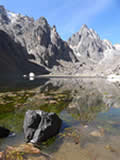 We decided to attempt a route on the attractive north facing slabs opposite Nevada Saturno. We inspected the faces and found several alluring lines, a couple of overhanging crack-lines to the east, some blank vertical slabs to the west, and up the middle was a large rightward curving crack, this looked to be the easiest line, and since it was our first climb we decided it would be best not to push ourselves too much. As it ended up we did push ourselves too much, we totally misjudged the route and it turned out to be an exciting, steep, dirt-filled crack. The dirt and shrubs would gradually slide down the crack and therefore the climbing involved attempting to move faster than the dirt was sliding. Stopping to catch your breath would give you an alarming feeling of being in sinking sand – as your hands and feet would begin to move downwards.
We decided to attempt a route on the attractive north facing slabs opposite Nevada Saturno. We inspected the faces and found several alluring lines, a couple of overhanging crack-lines to the east, some blank vertical slabs to the west, and up the middle was a large rightward curving crack, this looked to be the easiest line, and since it was our first climb we decided it would be best not to push ourselves too much. As it ended up we did push ourselves too much, we totally misjudged the route and it turned out to be an exciting, steep, dirt-filled crack. The dirt and shrubs would gradually slide down the crack and therefore the climbing involved attempting to move faster than the dirt was sliding. Stopping to catch your breath would give you an alarming feeling of being in sinking sand – as your hands and feet would begin to move downwards.
Photo above right: Laguna Blanca with Nevada Saturno in the background.
In the evening much to our dismay the stoves started acting up and extinguishing unexpectedly halfway through cooking supper. We later found that the petrol we were using was very dirty and was clogging them up; we started filtering the fuel through teabag linings.
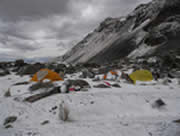 Over the next few days we continued exploring the area and climbing until clouds started growing and the weather deteriorated. Up to then the weather had been fine and sunny. That night several centimetres of snow fell. Photo left: Our base camp after the snow fall.
Over the next few days we continued exploring the area and climbing until clouds started growing and the weather deteriorated. Up to then the weather had been fine and sunny. That night several centimetres of snow fell. Photo left: Our base camp after the snow fall.
We couldn’t climb whilst everything was covered in snow so we went to look for more cliffs and found a truly inspiring piece of rock. It was four or five hundred metres of vertical (sometimes overhanging) rock. We decided we had to attempt it. We waited at base camp for a couple of days until the weather cleared and the snow melted. In the mean time we realised that some kind of rodent was nibbling on our cereals and chocolate so we ended up hanging all our food from bushes and boulders.
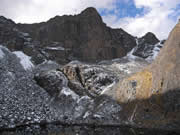 The big wall turned out to be very loose and deceptively steep, difficult and cold, with snow and ice on many parts of it. The amount of loose rock was overwhelming; the majority of handholds were loose enough to remove with a moderate pull. Rock that seemed solid at first would then move readily when pulled from a slightly different direction. If the rock had been solid the wall would have been superb, steep climbing, with very large holds. However, instead it was steep with very few solid holds and the constant stress of a potential fall with little protection. We did not have much success on the first day but found a promising line of weakness that we would pursue the next day.
The big wall turned out to be very loose and deceptively steep, difficult and cold, with snow and ice on many parts of it. The amount of loose rock was overwhelming; the majority of handholds were loose enough to remove with a moderate pull. Rock that seemed solid at first would then move readily when pulled from a slightly different direction. If the rock had been solid the wall would have been superb, steep climbing, with very large holds. However, instead it was steep with very few solid holds and the constant stress of a potential fall with little protection. We did not have much success on the first day but found a promising line of weakness that we would pursue the next day.
Photo right: The big wall.
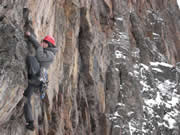 We started climbing up a diagonal crack just after a cold sunrise. The next section of climbing was cut short when we encountered an overhanging section. We spent half an hour clearing loose rock from a small platform so that we could build a safe anchor to protect ourselves. We had to stop clearing loose rock eventually when we realised that we were gradually destroying the platform that we were sitting on – the rock did not seem to get any more solid regardless of how deep we dug. On the next day it took us all day to traverse only eight metres whilst attempting to find the easiest way through overhanging section. Photo above left: Virgil climbing the big wall.
We started climbing up a diagonal crack just after a cold sunrise. The next section of climbing was cut short when we encountered an overhanging section. We spent half an hour clearing loose rock from a small platform so that we could build a safe anchor to protect ourselves. We had to stop clearing loose rock eventually when we realised that we were gradually destroying the platform that we were sitting on – the rock did not seem to get any more solid regardless of how deep we dug. On the next day it took us all day to traverse only eight metres whilst attempting to find the easiest way through overhanging section. Photo above left: Virgil climbing the big wall.
By the end of the next day we had tried all of our options, each one taking an extraordinary amount of time. Due to the loose rock, each move required excavation, cleaning and the testing of many potential handholds. We eventually decided that we should retreat and move on to a different route.
We carried our gear to camp in the valley to the north. The surrounding rock was all north-facing so it received sunlight for most of the day, which was a nice change. Unfortunately there was no running water nearby so we had to melt snow for water; the snow was full of grit so the water had an interesting texture.
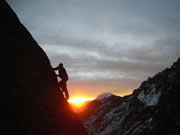 We found a spectacular route that had some of the highest quality climbing we had ever experienced, immaculate, solid granite, with a beautifully flowing sequence of climbing moves. It went smoothly, except for a diagonally rising traverse that turned out to be harder than expected and was covered with dirt and moss. About half way across I had to stop and clean it as it was becoming hard to see because of moss falling into my eyes. At one point I turned away form the wall to spit out some dirt, this unfortunately landed right on my climbing partner. In spite of this, route was an enjoyable finish to a wonderful trip.
We found a spectacular route that had some of the highest quality climbing we had ever experienced, immaculate, solid granite, with a beautifully flowing sequence of climbing moves. It went smoothly, except for a diagonally rising traverse that turned out to be harder than expected and was covered with dirt and moss. About half way across I had to stop and clean it as it was becoming hard to see because of moss falling into my eyes. At one point I turned away form the wall to spit out some dirt, this unfortunately landed right on my climbing partner. In spite of this, route was an enjoyable finish to a wonderful trip.
I feel exceptionally lucky to be studying at a university that supports this kind of endeavour. I would like to extend my gratitude to Lorraine Craig, Nigel Wheatley, Chris Green and all of the Imperial College Exploration Board members.
The members of the Imperial College Quimsa Cruz 2007 expedition would like to thank the following people and organisations for their kind support: Imperial College London, Sir Richard Sykes, Mount Everest Foundation, British Mountaineering Council, First Ascent, PHD Designs, Rab, and Terra Nova.
© 2007 Imperial College London
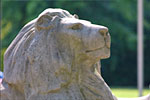
Through the first decade of the twenty-first century the campaign seeks to philanthropically raise £207 million from Imperial’s alumni, staff and friends, and donations from charitable foundations and industry.
Where your support can make a differenceGive now

Imperial’s Centenary Year provides an opportunity to recognise and celebrate members of the Imperial community.
View staff and student portraits